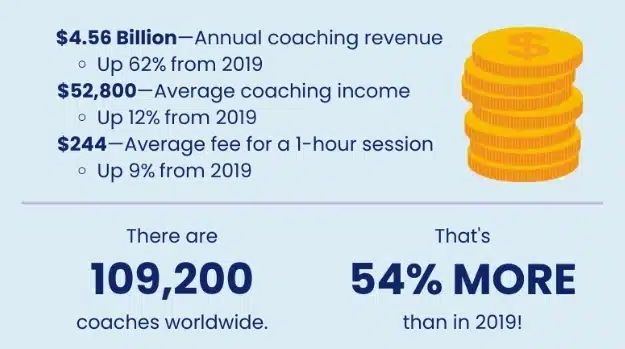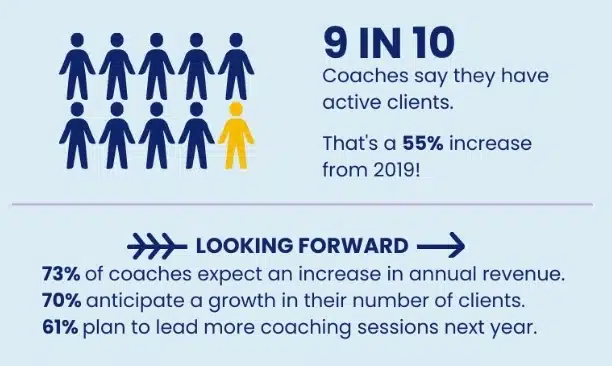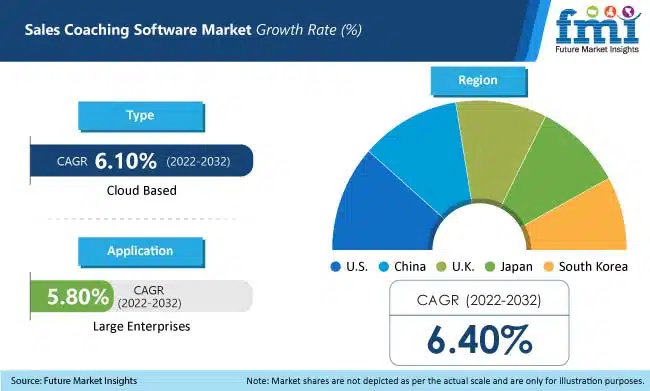
The latest life coaching statistics will show you how the industry has grown in the past five years. Life coaching has become a vital part of people’s lives. In fact, the demand for live coaches has significantly increased.
Life coaching is a personalized and goal-oriented approach to self-improvement. Everyone needs a life coach at some point in their lives.
However, what do statistics really say about the life coaching industry? Is it a lucrative profession? Should you invest in it, or is it another profession that will die off in the next five years?
Well, to answer your questions and give you further insights, I have arranged the latest life coaching statistics.
These life coaching statistics reveal the current state of the industry, showing you what to expect.
Types of Life Coaching
Since life coaching involves various aspects of life, including personal and professional, there are different types of life coaching. The term “life coaching” encompasses:
- Mental health and wellness coaching,
- Business coaching,
- Relationship coaching,
- Career coaching,
- Financial coaching,
- Executive coaching,
- Fitness coaching,
- Personal development coaching.
The best coaches are niche-based. They specialize in one type of coaching. These coaches are often experts who share their knowledge to guide their clients.
General Life Coaching Statistics
1. The global coaching industry market size was worth $5.34 billion in 2023. It is estimated to grow to $6.25 billion in 2024. (source)
2. As of 2022, the U.S. Life Coach industry market size was worth $1.5 billion. The market size grew by 2.5% in 2022. (source)
3. The U.S Life Coach industry is expected to grow at a CAGR of 4.85% between 2023 and 2030. The revenue is expected to be valued at $2.1 billion by 2030. This growth is due to increased demand for life coaches in different industries. (source)
4. There are over 109,200 life coaches worldwide. This is a 54% increase from the number of life coaches in 2019. (source)

5. A recent study found that 43% of people have used a life coach in the past. Another 22% say they are most likely to use a life coach in the future. (source)
6. The life coaching industry in the U.S. is divided into virtual and in—person methods. In 2022, the virtual segment accounted for 53.2% of the revenue share. The virtual segment will keep growing due to the increasing shift to technology. However, the in-person method will most likely grow because it builds trust and confidence between coaches and their clients. (source)
7. 74% of life coaches use more audio and video platforms for their sessions. (source)
8. As of 2022, there were 23,921 life coach businesses in the U.S. This figure is a 2.9% increase from the previous year. (source)
9. On average, life coaches earn between $30,000 and $80,000 yearly. However, top coaches can earn up to six figures yearly. (source)
10. In 2022, the annual revenue from practicing coaches totaled at $4.56 billion. (source)
11. In the U.S., the Life Coach industry is the second fastest-growing industry, with the first being the IT industry. (source)
12. 47% of Millennials say they have worked with a coach, compared to only 21% of Baby Boomers who have done so. (source)
13. 23% of coaches say uncertified coaches are the biggest obstacle in the life coaching business. (source)
14. The global executive coaching certification market size is expected to grow at a CAGR of 11.3%, amounting to $27 billion by 2032. (source)
15. California, Florida, and Texas are the U.S. states with the most registered life coach businesses. Each state has 812, 524, and 486 registered businesses, respectively. (source)
16. Up to 66% of Millennial coaches have less than five years of experience in coaching. This is high compared to the 40% of Generation X and 22% of Baby Boomers. (source)
17. Over 90% of practicing coaches say they have active clients. (source)

18. The most mentioned coaching topic/niche is Leadership, with 34%. (source)
19. Up to 93% of professional coaches offer other services besides coaching. They often offer consulting, training, and other facilitation services. (source)
20. Females (58%) are the majority of coaching clients. (source)
21. The average cost per one-hour coaching session is $244. (source)
22. Over 83% of companies plan to expand their top employees’ scope using coaching techniques for the next five years. (source)
23. The majority of the coach practitioners globally and in North America are women (70% and 74% respectively) (source)
24. Within four years, the number of female coaches in Asia grew from 52% to 59%. (source)
25. In North America, the coaching revenue grew by 36% between 2015 and 2020, amounting to $1.29 billion. (source)
26. The industry’s market volume is expected to be worth $5.20 billion by 2028. (source)
27. The average active coach has up to 12.2 clients. (source)
28. Coaches who offer extra services say they spend 44% of their time coaching. The other percentage is divided among the additional services they offer. (source)
29. Over 50% of coaches report that their clients consist mainly of managers and executives. (source)
Interesting Niche-Based Life Coaching Statistics
30. The sales coaching software market is expected to grow at a CAGR of 6.4% between 2022 and 2032, reaching up to $88.7 billion. (source)
31. The online coaching platform market size is expected to reach $45.6 billion by 2028. It will most likely grow at a CAGR of 13.03% between 2021 and 2028. (source)
32. The sales coaching software market was worth $47.6 billion in 2022 and is expected to increase to $88.7 billion by 2032. The market size is set to grow at a CAGR of 6.4%. (source)

33. Cloud-based sales coaching software is expected to grow the fastest in the industry, at a CAGR of 6.1%. (source)
34. Large enterprises will be the segment with the largest market share for the sales coaching software industry. This is because the market segment is set to grow at a CAGR of 5.8%. (source)
35. The U.S. (North America) is the region with the largest market share of sales coaching software. The market in this region is expected to grow at 6.2%, valued at $31.5 billion by 2032. (source)
36. In 2022, the revenue generated by the Business Coaching industry reached $13.9 billion. (source)
37. A business coach is a significant contributor to business growth. In fact, both Apple and Google owe their development to their business coach, Bill Campbell. (source)
38. Executive coaching has a strong ROI of 788%. (source)
39. Individuals who have executive coaching see a 70% boost in performance. Teams and organizations also experience a 50% and 48% boost in performance, respectively. (source)
40. Companies that offer only training experience a 22% increase in productivity. However, the figure rises to 88% when they include coaching too. (source)
41. One-third of successful entrepreneurs say they have gone to a business mentor or support group for advice. (source)
42. Between 2014 and 2019, the number of companies in the Netherlands offering business education increased from 6,100 to 8,500. (source)
43. The 2023 revenue of the Health and Wellness coaching industry in the U.S. is expected to increase to $3.13 billion. (source)
44. Between 2023 and 2028, the annual Health and wellness coaching industry growth rate is expected to grow at a CAGR of 10.69%. (source)
45. There are up to 109,000 health coaches in the world. (source)
46. When it comes to specificity and niche, male coaches are more likely to have specific niches, like business, compared to female coaches. (source)
47. According to ZipRecruiter, personal development coaches in the U.S. earn up to $56,712 yearly or $27 hourly. (source)
48. There are over 46,419 employed fitness coaches in the U.S. (source)
49. The average age of a fitness coach is 37 years old. (source)
50. The average salary of financial coaches is $48,165. (source)
51. The global health coach market size is expected to be worth over $29.12 billion by 2032. It’s expected to grow at a CAGR of 6.60% between 2023 and 2032. (source)

Latest Life Coaching Trends in 2024
1. Stronger Need for Accountability
Coaching is a very lucrative profession, with many coaches earning six figures.
Unfortunately, many see it as a way to make quick money, so they claim to be coaches and market themselves online. This is even easier as the barrier to becoming a coach is low.
However, as the demand for coaches keeps growing, there will be a strong need for accountability.
Clients would want to see proof of expertise before hiring coaches.
Furthermore, because the industry is becoming more competitive, coaches need to improve their skills. Mediocre skills won’t cut it anymore.
Intending coaches would have to get certification and practice more.
2. Coaching Will Become More Digital
In recent years, technology has become an integral part of our lives, personally and professionally. Almost all top-tier industries have adapted to this change, including the life coaching industry.
Digitization is an excellent way for coaches to interact with clients from all over the world. Clients can easily book appointments and attend coaching sessions.
It is now “old school” to thrive on only face-to-face sessions. Even so, coaches with multiple clients would use more online tools to simplify their tasks.
For example, they can take down clients’ notes and secure them on the cloud, use automation tools to reply to emails, and use online scheduling tools to book appointments and set reminders.
With these tools, coaches can simply focus on the primary tasks — focus on the clients.
3. Niche Coaching Will Get Higher Ground
The life coaching industry is very broad and saturated. There are over 109,200 coaches in the world.
To stand out, coaches are now focusing on niching down to meet specific clients and over specific values.
By niching down, coaches can discover their strengths and build on them.
In the coming years, clients’ needs will get more specific and targeted. They will need coaches who will directly help them in those needy areas.
4. A Focus on Coach-client Relationship
Excellent coaching thrives on trust, credibility, coach-client bonding, and strong relationships. In 2024 and beyond, you should expect a stronger focus on authentic coach-client relationships.
Regardless of the type of coaching involved, clients will genuinely understand the value of their coach when they relate with them.
It’s more than just telling clients what to do; it’s also about being human and meeting them at their level.
This means there will be more need for face-to-face sessions and live interactions. It helps ensure clients are correctly following.
5. Video Marketing will Become Preferred for Coaches
Statistics show in 2023, over 92% of all Internet users consumed video content. Videos have become one of the most popular and effective content formats for marketing, and coaches will begin using it more to their advantage.
Video content can reach a broader audience more than text and images.
Because people have a short attention span, coaches will have to use videos to grab their attention.
In a few minutes, coaches can explain who they are, what they do, and how they can help potential clients reach their goals.
Sharing such videos on social media is a great way to drive traffic to their website.
Conclusion
There you have it! The latest life coaching statistics to help you make informed decisions about your life coaching business in 2024.
Everybody needs a life coach, at least at some point in their lives. From the statistics, you can see that the life coach industry is an ever-green one that can only expect a boost in demand.
If you desire to enter the life coach industry, you need these statistics and trends to get a first-hand look at what to expect.

Recent Posts:
- 36 Interesting Social Worker Burnout Statistics for 2024
- 40+ Top Workplace Conflict Statistics You Should Know [2024]
- 73 Revealing Workplace Distraction Statistics [2024]
- 47+ Important 4-day Work Week Statistics You Must Know In 2024
- 39 Best Emotional Intelligence Statistics To Know
- 41+ Important Communication Skills Statistics & Trends
- 51+ Teamwork & Workplace Collaboration Statistics To Boost Your Employee Performance
- 51+ Important Podcast Advertising Statistics To Know
- 47+ Multi-Level And Network Marketing Statistics You Need To Know
- 81+ Sales Funnel Statistics To Help Improve Conversion Rates
- 15 Crucial Body Language Statistics To Know
- 53 Most Important Workplace Communication Statistics
- 100 Top Digital Marketing Vs. Traditional Marketing Statistics
- 50 Trade Show Statistics and Trends to Boost Your Business
- 41+ Multichannel Marketing Statistics and Trends
- 68 Incredible Performance Management Statistics & Trends

